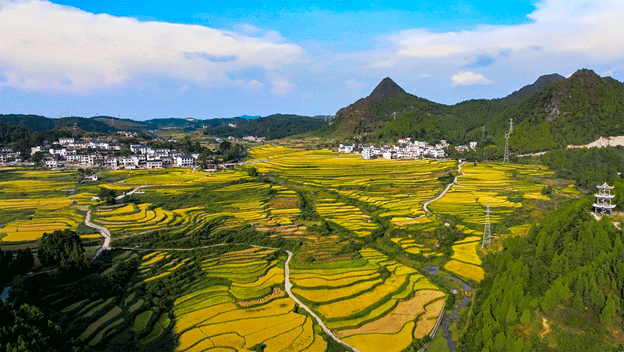Nestled in the scenic hills of southwest China’s Guizhou Province, Guojiawan Village in Yuping Dong Autonomous County is celebrating a bumper rice harvest this year. Stretching across more than 100 hectares, the village’s famous golden rice terraces shimmer in the autumn sun, filling the air with the pleasant aroma of ripening rice. These terraces, carefully sculpted over centuries, are not only a marvel of traditional farming but also a symbol of resilience and sustainability in agriculture.
A Tradition Rooted in History
Guojiawan Village’s rice cultivation dates back to ancient times, with its rice fields honored as tribute rice during the reign of the Qianlong Emperor (1736-1796) in the Qing Dynasty. This long-standing tradition of terrace farming has been passed down through generations, with local farmers preserving the meticulous practice of managing water, soil, and planting in these mountainous landscapes. Terrace farming in this region allows for efficient use of steep, otherwise unfarmable land, and helps control water runoff, making it a sustainable practice even in challenging terrain.
The 2024 Harvest: A Year of Abundance
This year, Guojiawan’s farmers are expecting one of their best harvests in recent years. The combination of favorable weather conditions and the expertise of local farmers has resulted in an estimated yield of over 7 tons per hectare. This is a significant achievement, considering the intricate manual labor involved in managing the terraced fields.
The village’s success reflects the broader trend of improved rice yields across Guizhou Province. According to data from the China National Rice Research Institute, Guizhou’s average rice yield has increased steadily in recent years due to the adoption of new agricultural techniques, including improved seed varieties and better water management practices. In 2023, the average rice yield in the province reached 6.3 tons per hectare, a notable improvement from previous years. Guojiawan’s rice terraces, though farmed with traditional methods, benefit from these advancements in agricultural science, ensuring that heritage farming practices can thrive alongside modern innovation.
Challenges and Sustainability
While this year’s harvest is abundant, terrace farming remains labor-intensive and vulnerable to climate variability. Guojiawan’s farmers continue to face challenges such as unpredictable rainfall and soil erosion, which can threaten the stability of the terraces. However, with growing interest in sustainable agricultural practices, the village has attracted attention from agronomists and agricultural researchers looking to learn from the centuries-old techniques that have preserved these fields.
In recent years, local governments and agricultural bodies have also invested in supporting terrace farmers by providing training in soil conservation, pest management, and the use of organic fertilizers. These efforts aim to ensure that the traditional practices of Guojiawan Village can continue to contribute to local food security while maintaining environmental sustainability.
The Future of Terrace Farming in Guizhou
As Guojiawan celebrates its 2024 bumper harvest, the village stands as a testament to the value of combining tradition with modern agricultural support. The ability to produce high-quality rice in the challenging terrain of southwest China speaks to the resilience of the local farming community. With ongoing support from agricultural organizations and increasing recognition of the importance of sustainable practices, terrace rice cultivation in Guizhou is poised to continue thriving for generations to come.
Guojiawan Village’s successful 2024 rice harvest highlights the enduring value of terrace farming, a practice that has sustained the local community for centuries. By blending traditional methods with modern agricultural innovations, the village not only ensures food security but also preserves an important cultural heritage. As other regions look for sustainable farming solutions, Guojiawan’s terraces offer valuable lessons in the resilience and adaptability of agriculture.
Error




